.jpg)
In fly tying, no natural material is more versatile, beloved, or misunderstood than deer hair. From the buoyant bomber riding high on a fast Atlantic salmon run to the sculpted head of a Muddler slicing through current, deer hair shows up everywhere—and for good reason.
But here’s the truth most tyers eventually discover:
👉 Not all deer hair is created equal.
👉 Different species behave differently on the vise.
👉 Hair from different parts of the same animal can vary dramatically.
Add in the unique characteristics of Whitetail, Mule Deer, Black-Tailed Deer, Northern/Boreal Deer, and Roe Deer, and it’s no wonder many tyers feel confused about what to use—and when.
This guide breaks it all down in a clear, actionable way so you can choose the right deer hair for every pattern, every time, whether you’re spinning a massive salmon bomber or tying tiny Comparaduns for spring creeks.
Now before we start lets narrow the discussion to the "traditional" understanding of "deer" and not the scientific classification which would include moose, elk and caribou which are considered part of the "deer" family. For purposes of this discussion we will stick to the traditional use of deer and the various main types that are most common to fly tying
Why “Deer Hair” Isn’t Just Deer Hair
Before diving into species and regions, it’s crucial to understand the five core properties that determine how deer hair behaves at the vise:
.JPG)
1. Buoyancy
Deer hair has hollow cellular chambers. The more hollow the hair, the more it floats.
But buoyancy varies heavily by:
- species
- climate the deer lived in
- body location
- season harvested
(This is why Northern/Boreal deer—surviving harsh winters—have unbelievably buoyant hair.)
2. Texture & Brittleness
A universal rule:
- Fine, stiff hair → wings, tails
- Coarse, hollow hair → spinning, packing, stacking
Texture is what makes belly hair flare explosively—and what makes tail hair brilliant for wings but terrible for spinning.
One deer is not the same as the next. Even within the same species there are differences in hair qualities, buoyancy and particularly length depending on when the deer was harvested. So if you can inspect before use buy. (Remove from the package and "feel" the hair. Pinch it to get a sense of coarseness and pay attention to the amount of underfur as well as hair coloring and banding especially if using for wing applications)
3. Flare & Compressibility
How much the hair spreads under thread pressure determines whether it’s ideal for:
- spinning
- stacking
- collars
- tight heads
- low-bulk wings
Not all hair flares. Some barely moves. Both are useful—just differently.

Some Torpedo Bombers - Early Ties
4. Durability
Some hair breaks easily. Some hair withstands teeth, rocks, and repeated casting.
Durable hair matters most for:
- Atlantic salmon bombers
- muddlers
- bass bugs
- hairwing salmon flies
5. Colour, Barbs & Markings
Natural variation allows tyers to imitate almost anything:
- caddis wings
- stoneflies
- minnows
- small mammals
- salmon bugs
Great tyers treat deer hair like a painter treats a palette.
Comparing Deer Species: Which Hair Does What?
Below is a species-by-species breakdown designed specifically for fly tyers.
Whitetail Deer — The All-Purpose Workhorse
Found across most of North America, Whitetail is the most accessible and widely used deer hair in fly tying.
Characteristics
- Medium–soft texture
- Excellent buoyancy
- Consistent compressibility
- Available in many natural colours
- Good length variation
Best Uses
- Spinning: Muddler Minnows, bass bugs, Bombers
- Dry fly wings: Comparaduns, caddis, extended bodies
- Tails (from premium tail hair)
Whitetail is your generalist—versatile, forgiving, and reliable.
Mule Deer — Soft, Subtle, Underrated
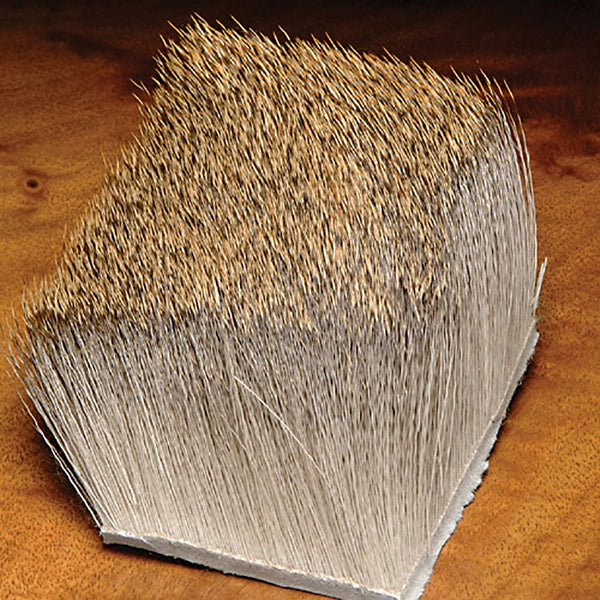
Common in western North America, Mule Deer hair is softer and often more delicate than Whitetail.
Characteristics
- Soft, compressible, more fragile
- Slightly less buoyant
- Excellent flare with minimal thread pressure
- Naturally grey or muted tones
Best Uses
- Light, low-bulk dry fly wings
- Smaller muddlers
- Patterns requiring gentle, controlled flare
Perfect for tyers who prefer subtle, refined movement over brute buoyancy.
Coastal Black-Tailed Deer — The Steelheader’s Secret
Found in the Pacific Northwest and coastal Alaska, Black-Tailed Deer hair behaves differently from both Whitetail and Mule Deer.
Characteristics
- Very fine fibres
- More solid core → less buoyant
- Extremely stiff → excellent shape retention
- Beautifully mottled colour patterns
Best Uses
- Hairwing steelhead & salmon flies
- Small collars for classic patterns
- Low-bulk dry fly wings
A favourite for west-coast tyers wanting crisp wing profiles that don’t collapse.
Northern / Boreal Whitetail — The Bomber King
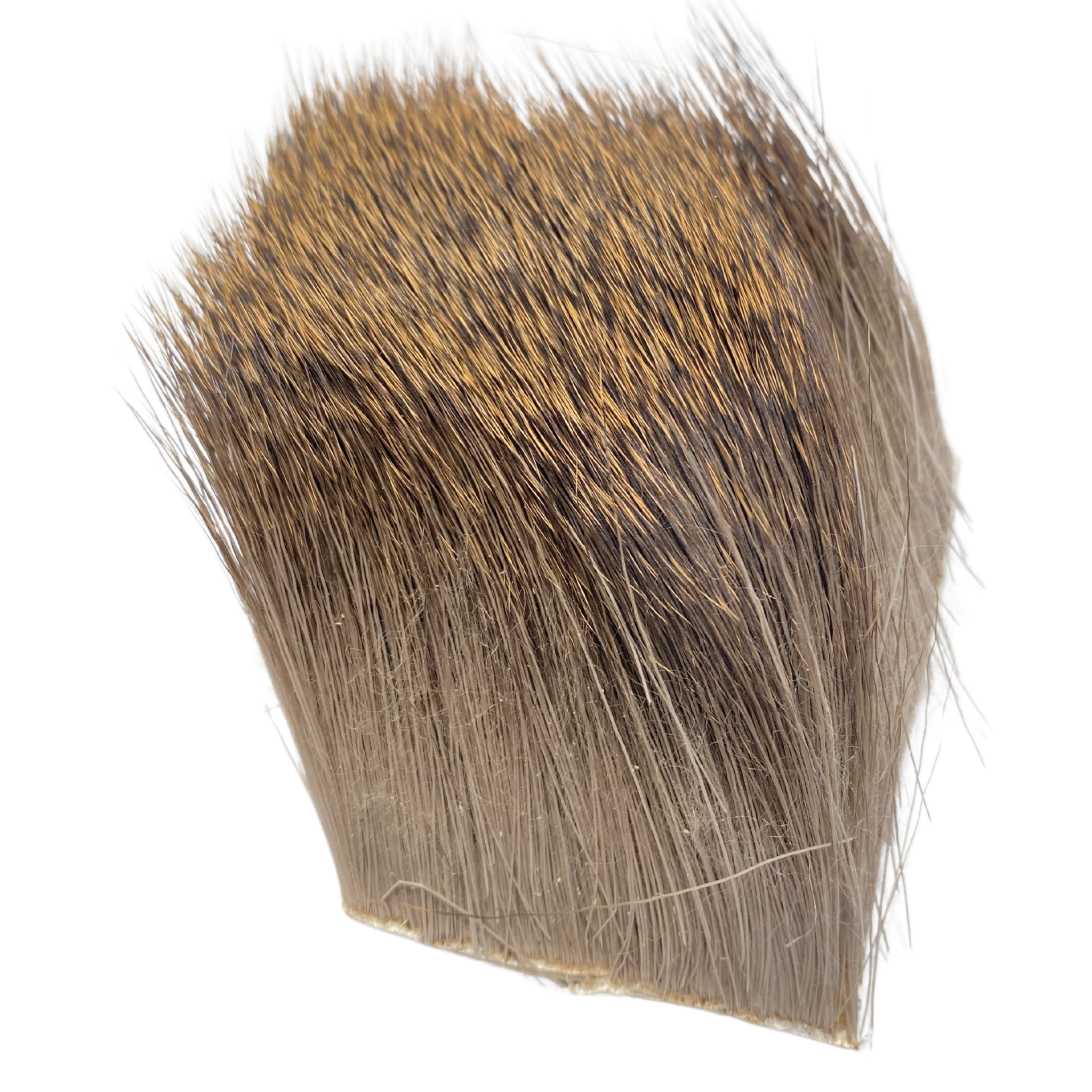
Cold climates create thick-walled hollow hair with unmatched buoyancy.
Characteristics
- Very dense, extremely buoyant
- Thick fibres that compress wonderfully
- Long, consistent lengths
- Exceptional for spinning
Best Uses
- Atlantic salmon Bombers
- Mice patterns
- Large spun-head streamers
If you tie big, buoyant, or bulky—this is your premium choice.
Roe Deer — The European Favourite (and a Hidden Gem)
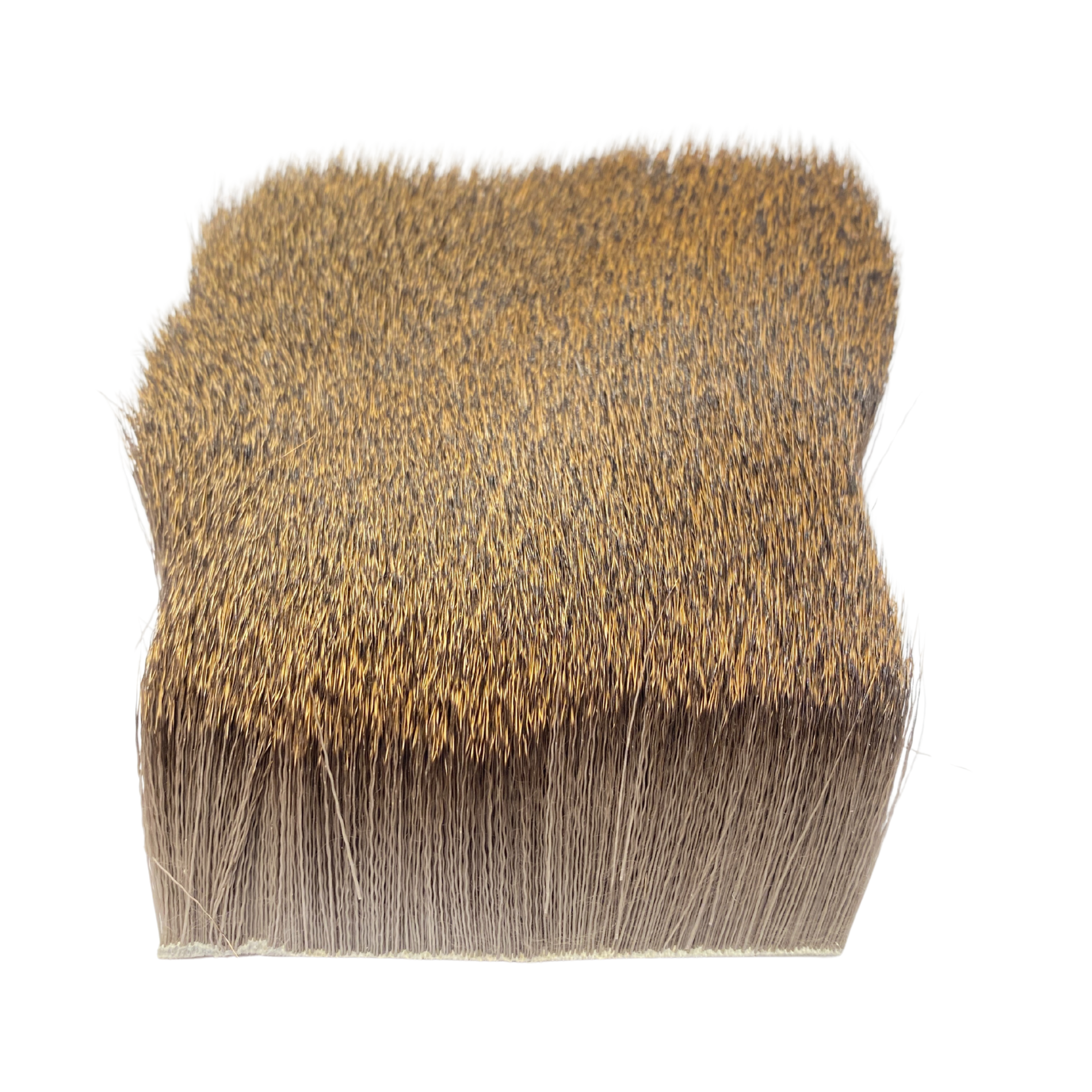
Roe Deer is increasingly appreciated by North American tyers for its fine, silky properties.
Characteristics
- Very fine diameter
- Smooth, delicate compressibility
- Moderate hollow structure (controlled flare)
- Subtle natural colours and tapered tips
- Excellent for small flies
Best Uses
- Small Comparadun wings
- Snowshoe rabbit substitutes
- Klinkhammer posts
- Sparse salmon bugs
- Small dry fly wings
- Subtle collaring
Roe deer excels where delicacy, precision, and finesse matter.
Where the Hair Comes From: Body Region Matters
Different areas of the animal provide remarkably different tying material.
Here’s your region-by-region breakdown:
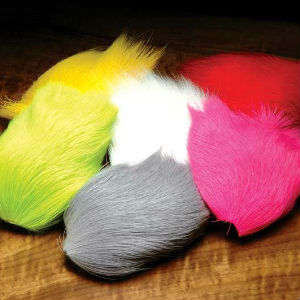
Deer belly Hair Patches
1. Belly Hair
Best For:
- Spinning & packing
- Bombers, Muddlers, bass bugs
Why:
- Highest hollowness
- Explosive flare
- Extremely buoyant
- Dyes beautifully
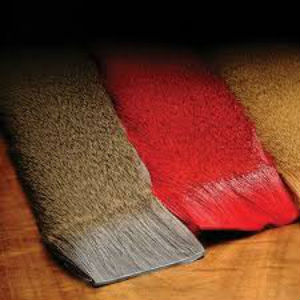
Select Wapsi Deer Back Strips
2. Back / Body Hair
Best For:
- Versatile wings
- Small collars
- Low–medium spinning
Why:
- Coarser than belly hair
- Moderately hollow
- Reliable and durable
A true multi-purpose section.
3. Flank Hair
Best For:
- Comparaduns
- Caddis wings
- Salmon fly collars
Why:
- Natural taper
- Soft wave
- Medium stiffness
One of the most underrated areas for dry fly work.
Practical Tips for Working With Deer Hair
✔ Use the right scissors
Dedicated serrated-edge scissors prevent slipping.
✔ Pick the right thread
- Flat thread → spinning
- GSP or Kevlar → large packed bodies
- Fine thread → wings & delicate work
✔ Comb out underfur rather than pulling
Prevents breakage—especially important with Roe Deer.
✔ Stack only when necessary
Not all hair benefits from alignment, especially belly hair.
✔ Buy from trusted suppliers
Even within the same species, quality varies dramatically based on:
- region
- season harvested
- age of animal
- hide preparation
Why Species & Selection Matter for the Fly Tyer
Choosing the right hair ensures:
- Flies float better
- Wings keep their shape
- Streamers swim more naturally
- Patterns cast lighter
- Your tying becomes more consistent
- Your flies last longer
For the Fly Fishing Adventurer, selecting the right deer hair isn’t just a detail—it’s a performance difference you feel in every drift.
Quick Comparison Chart: Deer Species vs. Best Uses
|
Deer Type |
Buoyancy |
Texture |
Best For |
Notes |
|
Whitetail |
High |
Medium |
Spinning, wings, tails |
Most versatile |
|
Mule Deer |
Medium |
Soft |
Low-bulk dries |
Flare with delicate handling |
|
Black-Tailed |
Low |
Fine/Stiff |
Salmon/steelhead wings |
Great shape retention |
|
Northern/Boreal |
Very High |
Coarse |
Bombers, big heads |
King of buoyancy |
|
Roe Deer |
Medium |
Fine/Soft |
Small wings, Euro dries |
Ideal for finesse flies |
FAQ: What New Tyers Always Ask
Q: Why does my deer hair keep breaking when spinning?
Likely using fine wing hair instead of hollow belly hair.
Q: Why does some deer hair flare wildly and some barely moves?
Different species → different core structure.
Q: Is dyed deer hair worse than natural?
Not necessarily—good-quality bleaching/dyeing actually enhances belly hair.
Q: Why does roe deer seem brittle?
It’s normal. It’s fine, delicate hair meant for subtle application.
Conclusion: Master Deer Hair, Master Your Craft
The more you understand deer hair—species differences, body sections, and behaviour at the vise—the more your tying transforms from “good enough” to consistently exceptional.
Whether you're shaping high-floating bombers for Atlantic salmon, sculpting muddlers, crafting delicate caddis wings, or tying subtle hairwing classics, choosing the right hair is the foundation of great fly design.
For the passionate tyer and the true Fly Fishing Adventurer, mastering deer hair isn’t just technical—it’s part of the joy of the craft.
Bring Your Flies to Life with Premium Natural Materials!
Ready to tie your next masterpiece? Explore our collection of authentic, hand-selected natural hairs — from Kid Goat to Finn Raccoon — sourced and prepared for serious tiers who value quality and tradition.
✨ Shop now at www.dctackle.ca and discover materials that move, shimmer, and fish like the real deal.
💥 Join our Fly Fishing Adventurers’ mailing list for 10% off your first order and insider access to exclusive tying tips, tutorials, and early product releases.
👉 Visit the Shop → — Because the perfect fly starts with the perfect material.
.png)






